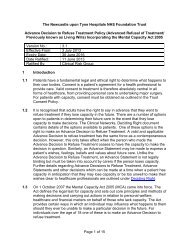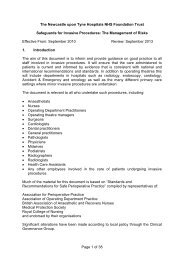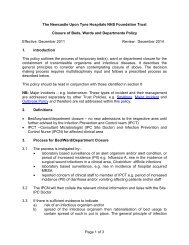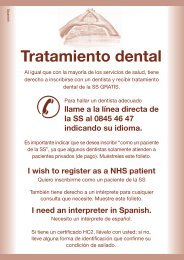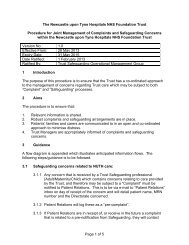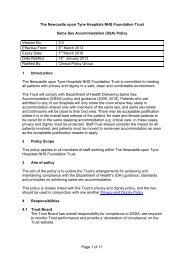Patient leaflet Nebulised inhaled Gentamicin - Newcastle Hospitals
Patient leaflet Nebulised inhaled Gentamicin - Newcastle Hospitals
Patient leaflet Nebulised inhaled Gentamicin - Newcastle Hospitals
You also want an ePaper? Increase the reach of your titles
YUMPU automatically turns print PDFs into web optimized ePapers that Google loves.
<strong>Newcastle</strong> Bronchiectasis ServiceCardiothoracic Directorate<strong>Nebulised</strong> (<strong>inhaled</strong>) <strong>Gentamicin</strong>Your doctor has prescribed a drug called gentamicin for you. This is an <strong>inhaled</strong> drug, whichis one that you breathe in. This information sheet tells you about the drug and how it will begiven. This will allow you to take this drug safely at home. There are also some instructionsshowing you how to maintain the equipment and some contact numbers if you need help.What is nebulised gentamicin?<strong>Gentamicin</strong> is an antibiotic that is used to treat a number of infections. This medicine can begiven by injection into your muscle or vein, or it can be put into a device called a nebuliserand then <strong>inhaled</strong>. The nebuliser converts the liquid gentamicin into a mist which you canbreathe in. This will take around 15 minutes.There are several gentamicin preparations available in the UK, however not all of themshould be used in a nebuliser. This is because some brands of gentamicin contain alcoholwhich is not suitable for nebulisation. Current brands which are suitable to be used in thenebuliser are Cidomycin ® and Genticin ® .Why do I need nebulised gentamicin?Research studies have shown that if you have certain conditions such as bronchiectasis,regular treatment with <strong>inhaled</strong> antibiotics can reduce the number of bacteria in your lungswhich means that:• you may have fewer flare ups of your chest• you may have less admissions to hospital• your symptoms may improve• your lungs may stay healthier for longer• In some patients this treatment can kill off certain bacteria.How do I use nebulised gentamicin?You will be shown how to prepare and administer the antibiotic, how to clean the nebuliserand how to operate the compressor (the machine that drives the nebuliser). We will give youanother <strong>leaflet</strong> explaining this.We also provide written instructions on how to use the nebuliser. For more information seethe section in this <strong>leaflet</strong> called ‘Instruction for the use of nebulised <strong>Gentamicin</strong>’.1
Once you have set the nebuliser up, it usually takes around 15 minutes to breathe in theentire gentamicin dose from the nebuliser.What are the possible side-effects?As with all medicines <strong>inhaled</strong> antibiotics can cause some side-effects, the most common oneis chest tightness. Some patients are unable to take <strong>inhaled</strong> antibiotics because of this.The first time that you have <strong>inhaled</strong> antibiotics we will give you a ‘test’ dose on ward 29 andmonitor your lung function. If it is safe to do so, then we start the <strong>inhaled</strong> antibiotic on a morepermanent basis.If you do experience tightness of the chest sometimes we can give another <strong>inhaled</strong> medicinecalled salbutamol to help you take the <strong>inhaled</strong> antibiotic. Salbutamol is usually given in thenebuliser before the dose of antibiotic is <strong>inhaled</strong>.If your chest becomes tight when you are at home, stop the <strong>inhaled</strong> antibiotic for 2-3 days. Ifyour symptoms improve then it’s likely to be related to the <strong>inhaled</strong> antibiotic. Stop thetreatment and let us know by contacting Dr De Soyza’s team (numbers below). If yoursymptoms do not improve then they are likely to be caused by something else and youshould contact your GP.Inhaled <strong>Gentamicin</strong> and Pregnancy.Do not use <strong>Gentamicin</strong> if you are pregnant. It could harm the unborn baby. Use effectivebirth control, and tell your doctor if you become pregnant during treatment.It is not known whether <strong>Gentamicin</strong> passes into breast milk or if it could harm a nursing baby.You should not breast-feed while using this medicine.How long will I be on treatment?If you are happy with the <strong>inhaled</strong> treatment then we will usually recommend that you stay onit for a trial period of 3 - 4 months. If it is effective then we would recommend that you remainon this drug long term.Where do I get the equipment from?We will supply you with a compressor unit and nebulisers and other equipment.The hospital will give you a month’s supply of the drug and anything else you will need touse this medicine (for example needles, syringes, a sharps bin). We will contact your GP toask them for a further supply of everything when you are at home.If you have any problems with the supply of equipment, please let us know as soon aspossible so you don’t miss any doses. You can dispose of your sharps bin at your local GPsurgery or pharmacy. Alternatively you can bring it back to the hospital.2
Instructions for the use of nebulised <strong>Gentamicin</strong>Your treatment is called <strong>Gentamicin</strong> and the dose is 80mg. You should take this treatmenttwice per day, around 12 hours apart.Equipment required• One vial of gentamicin 80mg• One 5ml syringe• One blue needle• One vial of sodium chloride 0.9% (5ml)• Nebuliser• Sharps boxInstructions1. Wash and dry hands2. Prepare a clean surface as directed3. Put the blue needle onto the syringe4. Carefully snap open the <strong>Gentamicin</strong> vial – check that the expiry date of thegentamicin5. Open up the vial of sodium chloride 0.9%6. Draw up the 2ml of 80mg <strong>Gentamicin</strong>7. Draw up a further 2ml of sodium chloride 0.9%. You should now have a total of 4ml inthe syringe.8. Add this gentamicin and saline mix into the nebuliser chamber9. Dispose of the needle/syringe into a sharps bin (your GP can dispose of full sharpsbins and give you a new one)10. Put the nebuliser together and you’re ready to nebulise.11. When nebulisation is finished is finished – rinse the chamber and mouth piece anddry thoroughly.Remember• Use a new needle and syringe for every dose you make up• Dispose of your sharps immediately• Don’t make up more than one dose at a time. Make them up as you need them.3
• Your compressor will need a service once per year. Please arrange this with the lungfunction department.4
Looking after the nebuliserYou will be using a special nebuliser with an exhaust filter. This is to limit antibiotic escapeinto the surrounding air. There is a filter pad contained within it, and this should be changedevery time you use the nebuliser.Even when using this filter, some antibiotic will escape into the surrounding air. Therefore,you should nebulise with the window open and the door shut. After nebulising, leave thewindow open for at least 30 minutes, again with the door shut.• You can wash your nebuliser with warm soapy water daily.• You should also boil it in water with a few drops of washing up liquid for 10-15minutes once a week.For further informationContact details• John Davison Specialist Nurse – Complex Lung Disease Tel: 0191 2139114 (forgeneral advice - Monday to Friday 8:30am – 4:30pm)• Dr. De Soyza’s Secretary 0191 2137468 (for questions about appointments - Mondayto Friday 9.00am – 5.00pm )• Lung Function Department 0191 2137780 (for advice about the nebuliser /compressor - Monday to Friday 9.00am – 5.00pm )• Ward 29 0191 2137029 (for out of hours advice - 24 hours a day)Medicines Information <strong>Patient</strong> helpline on 0191 2823016 Monday to Friday 9.00am to4.00pm (excluding bank holidays)The <strong>Patient</strong> Advice and Liaison Service (PALS) can offer on-the-spot advice and informationabout the NHS. You can contact them on freephone 0800 032 02 02 or e-mailnorthoftynepals@nhct.nhs.ukUseful websitesIf you would like further information about health conditions and treatment options, you maywish to have a look at the NHS Choices website at www.nhs.uk. On this website there is aninformation prescription generator www.nhs.uk/ips which brings together a wealth ofapproved patient information from the NHS and charity partners which you may find helpful.Information produced by: John Davison (MSc RGN, Specialist Nurse – Complex LungDisease)Date: July 2013Review date: July 20155


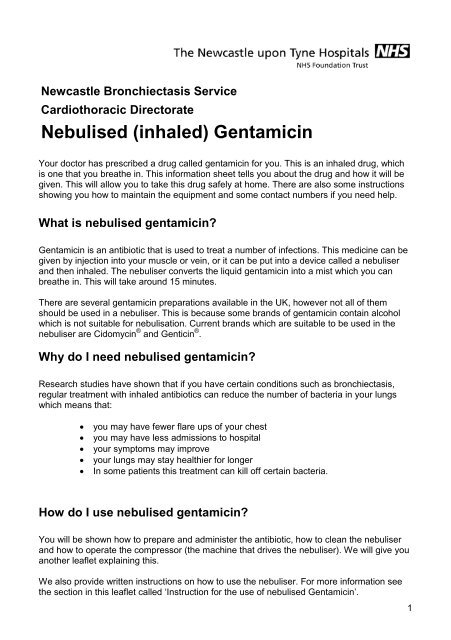
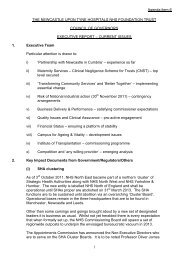
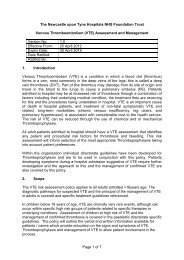
![Standard Precautions Policy - 112KB [PDF] - Newcastle Hospitals](https://img.yumpu.com/51150129/1/184x260/standard-precautions-policy-112kb-pdf-newcastle-hospitals.jpg?quality=85)
![Oxygen Management Policy - 38KB [PDF] - Newcastle Hospitals](https://img.yumpu.com/50798872/1/184x260/oxygen-management-policy-38kb-pdf-newcastle-hospitals.jpg?quality=85)
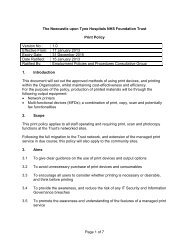
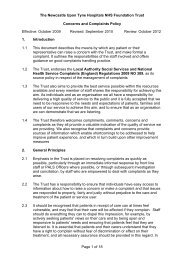
![Patient Identification Policy - 130KB [PDF] - Newcastle Hospitals](https://img.yumpu.com/49156101/1/190x245/patient-identification-policy-130kb-pdf-newcastle-hospitals.jpg?quality=85)
